Disclosure: We may earn commissions if you purchase products after clicking on a link from our site.
If you’re looking to bring in the bucks, you need to learn how to attract deer. Luckily, we’ve got all the tips and tricks you need to know! Deer are creatures of habit, so if you can get them used to your scent or presence, they’ll keep coming back for more. In this blog post, we’ll discuss how to use food, scents, and other strategies on how to get deer to come out during the day and make them feel at home on your property.
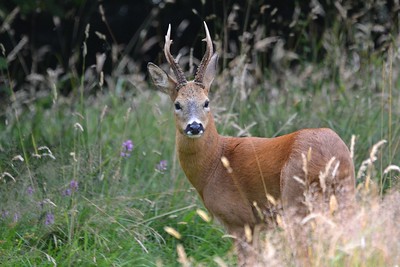
Table of Contents
How To Attract Deer To Your Yard
1. Know The Local Laws
The first thing you want to do is check your local laws concerning creating a feeding area. In some states, building a feeding area during certain times of the year is not legal. Make sure it is legal to build a feeding area before you start. Attracting deer to your yard can be easily implemented but you want to be sure what you do isn’t illegal.
2. Plant A Food Plot
Deer are attracted to protein-rich crops like alfalfa, peas, soybeans, turnips, kale, etc. Plant a food plot to attract them to your area. You can also plant clover, and grasses like wheat, oats, and rye. Deer also like nuts such as acorns and chestnuts.
Apples, pears, and persimmons are also fruits that deer love and will attract them to your yard. Deer also love corn. Take note of what is not in your area that deer love and plant those to attract deer to your plot.
Visit your local hunting store and ask for seed mixes for deer plots. Some stores sell bulk seeds that will allow you to create your own blends with winter peas, fescue, vetch, and sun hemp.
How to attract deer in the daytime involves implementing a number of strategies that appeal to deer.
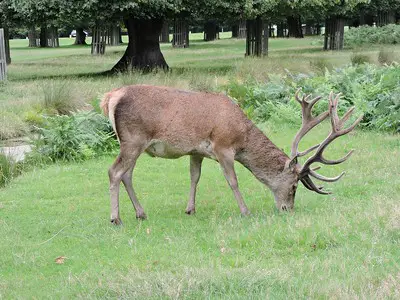
3. Away From Roads
Don’t plant your food plot close to roads and busy areas that have a lot of human traffic. Deer will be hesitant to come to your food plot if there is a lot of human traffic.
4. Water Source
Deer get thirsty and need water to drink. Create a water source or improve one by planting trees around a water source to create more cover for deer when they drink. If it is possible creating a water source or using one close to your area is one way how to attract deer to your yard.
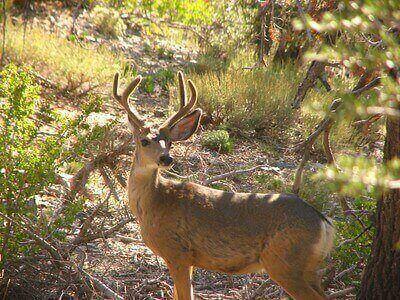
5. Provide A Salt Or Mineral Block
Deer are attracted to salt and mineral blocks. They are also drawn to cider and apple salt blocks. Set up a salt block near your food plot or bury it in the ground. Sprinkle salt on top of the ground after burying the salt block. You can find salt blocks at feed stores and hunting goods stores. How to attract deer to your yard can be accomplished with a salt or mineral block.
6. Plant Trees
Plant trees whose leaves deer eat. Not only the leaves will serve as food but the trees will provide cover that deer love. You can plant apple trees, willow trees, oaks, hawthorn, cedar, yew, and dogwood. This is a long-term strategy. This is a long-term strategy but is another way how to attract deer to your yard.
It will take years for trees to grow and mature to become cover and provide many leaves for deer. But if you have the bigger picture and are patient, this will serve for many years as the deer will come to know the area and eat and bed there.
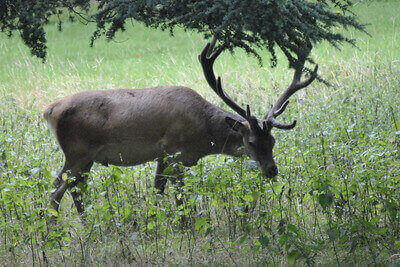
7. Use Deer Lure
Using a deer lure is one of the best ways how to attract deer to your yard. You can find them at sporting goods stores. Deer urine could be used as deer lures but it is illegal in some states. Check your local laws regarding using deer urine as a lure before you use it. Deer lure can be a very effective way how to get a deer to come to you but you must be sure it is legal in your state.
8. Tall Grass
Let the grass grow beyond average height in the area you want to attract deer. This will be welcoming to deer as they like to cover the areas they frequent.
9. Remove Fences
Fences and other barriers prevent deer from easy access to the land. If you have fences in the area that you want to attract deer, consider removing the fence. This will create a more welcoming plot for them to easily roam and find food.
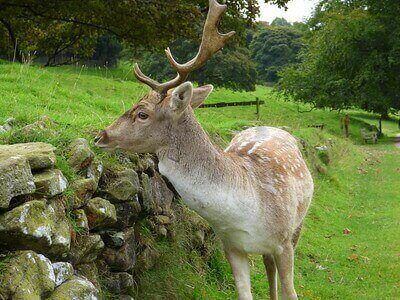
10. Pines or Cedars
Growing pine or cedar trees can be an effective strategy for attracting deer to your yard. Both pine and cedar trees provide valuable cover and shelter for deer, offering them protection from predators and the elements.
Additionally, these trees produce an abundance of nutritious foliage and twigs that deer find palatable, especially during the winter months when other food sources may be scarce. The dense branches and evergreen foliage of pine and cedar trees also offer deer a sense of security, making them feel comfortable and safe while browsing in your yard.
By planting and cultivating these trees on your property, you can create an inviting habitat that encourages deer to visit regularly, providing you with the opportunity to observe these majestic creatures up close and enjoy their presence in your outdoor space.
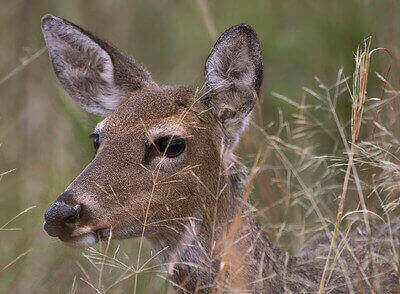
11. Well-Drained Location
Using a well-drained location can be a strategic approach to attract deer to your yard. Deer are naturally drawn to areas with reliable water sources, and well-drained locations often provide access to fresh water and lush vegetation.
By selecting a spot with good drainage, you can create an environment that supports the growth of various plants and grasses that deer find appealing for foraging. Additionally, well-drained areas are less likely to become waterlogged or muddy, which can deter deer from frequenting the area.
Providing a consistent and accessible water source in a well-drained location can enhance its attractiveness to deer, as they rely on water not only for hydration but also for bathing and grooming. Overall, choosing a well-drained location for your yard can increase the likelihood of attracting deer and create an inviting habitat that encourages their presence.
12. Brush Pile
Using a brush pile can be an effective method for attracting deer to your yard. Deer are naturally drawn to areas with cover and shelter, and a well-constructed brush pile can provide both protection and food sources for them.
When building a brush pile, consider using a variety of materials such as fallen branches, leaves, and twigs to create a dense and diverse habitat. This will not only offer deer a place to seek refuge from predators but also provide them with opportunities for browsing and foraging.
Additionally, brush piles can serve as bedding areas for deer, especially during harsh weather conditions or when they need to rest. By strategically placing a brush pile in your yard, you can create a welcoming environment that encourages deer to visit and explore, making it a rewarding experience for both you and the wildlife.
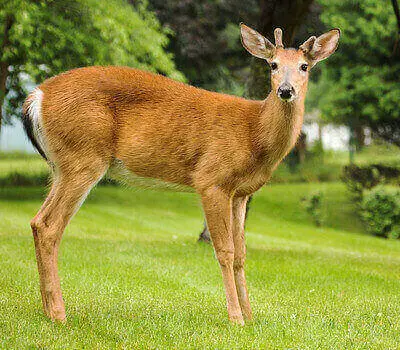
Don’t Lure Deer With These Foods
There are some food items that you may not be aware of that deer don’t like. They will not lure deer to your yard.
1. Hay
While hay may seem like a convenient option for luring deer, it’s important to avoid using it for several reasons. Firstly, hay lacks the nutritional value that deer need for their diet. It’s low in protein and other essential nutrients, which may not adequately sustain the health of deer, especially during harsh winter months or periods of high energy expenditure like the rutting season.
Moreover, hay can also pose a choking hazard to deer, particularly if it’s moldy or contains foreign objects. Additionally, using hay to attract deer can inadvertently encourage them to become dependent on human-provided food sources, disrupting their natural foraging behaviors and potentially leading to overpopulation and habitat degradation.
Instead of relying on hay, it’s better to focus on creating natural food plots, planting native vegetation, and providing mineral supplements to support the nutritional needs of deer while promoting their overall health and well-being.
2. Kitchen Scraps
While it may be tempting to use kitchen scraps as a convenient way to lure deer, it’s important to refrain from doing so for several reasons. Firstly, kitchen scraps such as fruits, vegetables, and leftover food items may not provide the necessary nutrition that deer require for their diet.
These scraps often lack the essential proteins, vitamins, and minerals that deer need to thrive, potentially leading to nutritional deficiencies and health problems. Moreover, feeding deer kitchen scraps can habituate them to human-provided food sources, leading to unnatural behaviors and increased risks of conflicts with humans and pets.
Additionally, some kitchen scraps may be harmful or toxic to deer if they contain substances such as salt, spices, or other additives commonly found in human food. To support the health and well-being of deer, it’s best to focus on natural forage options, supplemental feeds specifically formulated for deer, and habitat enhancement practices that promote their natural diet and behavior patterns.
3. Animal Meat
Using animal meat to lure deer is not recommended for several reasons. Firstly, it can attract unwanted predators to the area, posing a threat to both the deer and other wildlife.
Additionally, introducing meat into the environment can disrupt natural food chains and lead to imbalances in local ecosystems. Moreover, the scent of meat may not be appealing or recognizable to deer, as they primarily rely on plant-based foods for their diet.
Feeding deer meat can also increase the risk of spreading diseases or parasites among the deer population, as well as attract scavengers that could spread these pathogens further. Overall, it’s best to avoid using animal meat as bait and instead focus on natural forage options and habitat management practices to attract and support deer populations.
The Bottom Line
How to attract deer to your yard involves creating an attractive environment for the deer that caters not only feeds it, but also gives it a sense of safety with a cover that includes trees, brush, leaves, and other items. In this article, we discuss how to get a deer to come to you by creating an environment that will lure deer to your yard. If you want to learn how to hunt deer with a crossbow, then you should read this article.
If you are interested in deer attractants, then read this review of the best deer attractants to find the right one for attracting deer to your hunting area, food plot, or your property. You can also read how to hunt deer at night, how to hunt whitetail deer during the rut, the best deer feeders, the best deer food plot seeds, the best tripod game hoists, and the best deer carts.